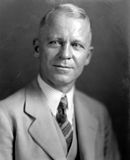| |||||||||||||||||
| |||||||||||||||||
 County results McKelvie: 40–50% 50–60% 60–70% 70–80% Neville: 40–50% 50–60% 60–70% 70–80% | |||||||||||||||||
| |||||||||||||||||
| Elections in Nebraska |
|---|
 |
The 1918 Nebraska gubernatorial election was held on November 5, 1918, and featured former lieutenant governor Samuel R. McKelvie, a Republican, defeating incumbent Democratic governor, Keith Neville.

